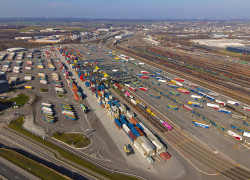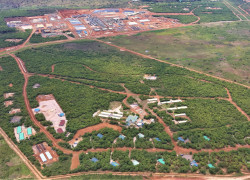"Chinese growth could help the eurozone"
Dr Mathilde Lemoine, Group Chief Economist of Edmond de Rothschild, has published her macroeconomic forecasts for 2019 and 2020.
As we anticipated, the United States is at the heart of global growth and sets the international economic agenda. Beyond his domestic growth objective, the Chinese President cannot allow his country to fall behind the United States in terms of leadership. This is why the recovery plan already initiated by Xi Jinping must be completed. The Asian source of world growth would limit the negative impact and continuing uncertainty related to the United Kingdom’s exit from the European Union, the risk of an increase in the number of seats won by anti-European parties in the European elections on 26 May 2019, tensions between Italy, Germany and France and the opening of new US trade negotiations with the European Union and the United Kingdom.
As a result, if China completes its recovery plan as we anticipate, its growth could accelerate slightly in the first half of 2019 to 6.7%. American growth, although weakened by the end of the effects of the recovery plan, would reach 2.7%, thanks to strong household consumption. Eurozone GDP would only grow by 1.5% in 2019 and 1.4% in 2020.
The United Stated : Central to global growth
The analysis led Mathilde Lemoine’s Economic Research teams to consider that tax reforms could have a structural rather than solely a cyclical impact on economic activity in the United States. Initial figures show that this was the case in the first half of the year given that production capacity increased. In addition, new workers entered the labour market, which limited wage increases.
As a result, growth could remain very dynamic in 2019, supported by household consumption and the persistent effects of tax reforms on the competitiveness of US companies. That is why we forecast growth of 2.7% in 2019 after 2.9% in 2018 and no recession in 2020.
Eurozone : Destabilising institutional vacancies arising
After a period of playing catch up, growth in the Eurozone is running out of steam. In addition, 2019 is a year of institutional change, which will fuel uncertainty. Notably the prospect of an increase in the number of representatives of anti-European parties in European institutions and a central bank president less willing to implement unconventional actions will increase the Eurozone's political risk premium and volatility in bond markets. In addition, our analysis of trade flows and the specificities of European trade policy shows that the Eurozone could be the big loser in the China-US trade war.
The American objective is to gain market share from its trading partners. After the increase in customs duties, the Americans opened bilateral negotiations with the European Union. They want to push the Europeans to increase their agricultural imports under the threat of higher tariffs on car imports into the United States. At the same time, China is looking for new markets to limit the negative impact of tariffs on export volumes.
Eurozone GDP growth is likely to record an increase of just 1.5% in 2019 and 1.4% in 2020. However, the depreciation of the Euro would be limited by the reduction of outgoing financial flows and the greater control of clearing houses dealing in Euros by the European Central Bank.
Chinese recovery plan : Decisive for the stability of world growth
The slowdown in growth in the third quarter to 6.5% was due to the sharp fall in infrastructure investment rather than the trade war. To maintain a growth rate close to its 6.5% target, the government has initiated monetary easing and announced tax cuts for both households and businesses. This recovery plan is crucial for global growth.
Investment in Chinese infrastructure has a direct impact on the price of raw materials, on the activity of countries exporting raw materials, on world trade and on industrial production in developed countries. It is this virtuous circle that was triggered in 2016 after the fall in China's growth.
Beyond his domestic growth objective, the Chinese President cannot allow the country to fall behind the United States in terms of leadership. This is why we anticipate a slight acceleration in Chinese growth to 6.7% in the first half of 2019.
If our forecast of even a modest acceleration in Chinese growth were to be confirmed, emerging countries could then take a break from the rise in their key rates. Indeed, the Indonesian, Philippine and Indian central banks had been forced to increase them to avoid an inflationary fall in the currency, which restrained lending. In addition, some countries such as Brazil and Turkey, which have suffered particularly from political uncertainties, may see their economic activity recover in the first half of the year. Growth in emerging countries is expected to stabilise at 4.8% in 2019, based on our predictions.
Conclusion : Will the eurozone succumb to the recovery plan?
The acceleration of growth in the United States has confirmed the hypothesis of desynchronisation of global growth, which has destabilised emerging countries. At the same time, fears of a decline in world trade weighed on their business prospects. Most emerging central banks were forced to raise their key rates to avoid a sharp depreciation of their currencies, which further reduced growth. The Chinese authorities have relaxed their monetary policy to prevent a further deceleration in growth resulting from the fall in infrastructure investment. The credibility of the Chinese recovery plan is crucial for stabilising global growth in early 2019.
Against a backdrop of low growth, the European Union will face a renewal of its institutions with the risk of an increased presence of anti-European parties. In addition, the Eurozone is likely to become the big loser in the China-US trade war.
As a result, even if global growth only slows down in the second half of 2019 thanks to an extension of the Chinese recovery plan, the European institutional renewal deadlines and the trade war will maintain high levels of volatility in the bond markets. The increase in US and Chinese debt will also contribute to this scenario.
Without growth drivers and given the presence of intense political tensions and the guarantee that the European Central Bank will not raise its key interest rate before 2020, will the Eurozone also succumb to the recovery plan trend? Although this initiative would stabilise short-term growth prospects, it would also jeopardise medium-term growth prospects. Mathilde Lemoine concludes that potential growth depends, as ever, on productivity.
Communiqués liés
RSA launches technology and management liability insurance s...
RSA Luxembourg, part of Intact Insurance Specialty Solutions, today announces th...
Lancement d'une nouvelle connexion intermodale entre Bettemb...
CFL multimodal a le plaisir d'annoncer le lancement de sa nouvelle connexion i...
Experts from LUNEX award first micro-credentials in Rwanda o...
The Rwanda Ministry of Education (MINEDUC) formally inaugurated Syllabi, a publi...
ERG Notes that ENRC Secures Landmark Victory as Court of App...
Eurasian Resources Group (ERG), a leading diversified natural resources group he...
LetzToken et La Vie est Belle annoncent leur partenariat ouv...
«?LetzToken?», plateforme de tokenisation pionnière basée à Luxembourg, et ...
ERG announces a Pre-Export Finance Facility Agreement based ...
Eurasian Resources Group (“ERG”, “The Group”), a leading diversified nat...
Il n'y a aucun résultat pour votre recherche







